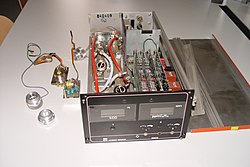Non-dispersive infrared sensor
A non-dispersive infrared sensor or NDIR sensor is a spectroscopic device that is mainly used as a gas sensor . NDIR analyzers are particularly suitable for determining the concentration of carbon monoxide , carbon dioxide or hydrocarbons in a gas. A typical area of application is the analysis of exhaust gases from internal combustion engines . In contrast to technically more complex dispersive processes (e.g. FTIR), non-dispersive IR sensors work without the finely divided spectral breakdown of infrared light.
principle
The most important components are a source for infrared radiation , an irradiated tube ( cuvette ) with the gas to be analyzed, a wavelength filter and an infrared detector . The gas to be examined is either pumped into the sample chamber or diffuses into this chamber. The concentration of the gas sought is measured electro-optically via the extent of absorption of a specific wavelength in the infrared spectrum . The light from the infrared source shines through the gas in the sample chamber, the filter and then hits the IR sensor. The function of the filter is to allow only a very narrow spectrum from the spectrum of the light source to pass through, the frequency of which is selected so that it is effectively absorbed by the molecules of the gas being examined. Ideally, the other gases contained in the gas mixture of the sample should not absorb light of this wavelength.
A second, identically constructed tube (in the device in the picture the other half of the tube divided by a central bar) contains an enclosed reference gas, for example nitrogen. The measuring cuvette and the reference cuvette are integrated in the same measuring system and are irradiated alternately, whereby the switching can take place, for example, by rotating perforated disks (chopper).
Since many gases absorb light in the infrared range, compensation for existing interfering but not investigated gas components is often necessary. For example, the absorption of the gases CO 2 and H 2 O influence each other in the measurement result due to the spectral proximity of their absorption characteristics.
The IR signals used are often modulated or pulsed in order to compensate for thermal phenomena.
Individual evidence
- ↑ Dissertation, Stephan Schmidt, Development of two-component methods for nondispersive IR spectroscopy (NDIR) with the help of chemometric methods, Duisburg, 2003. Dissertation
